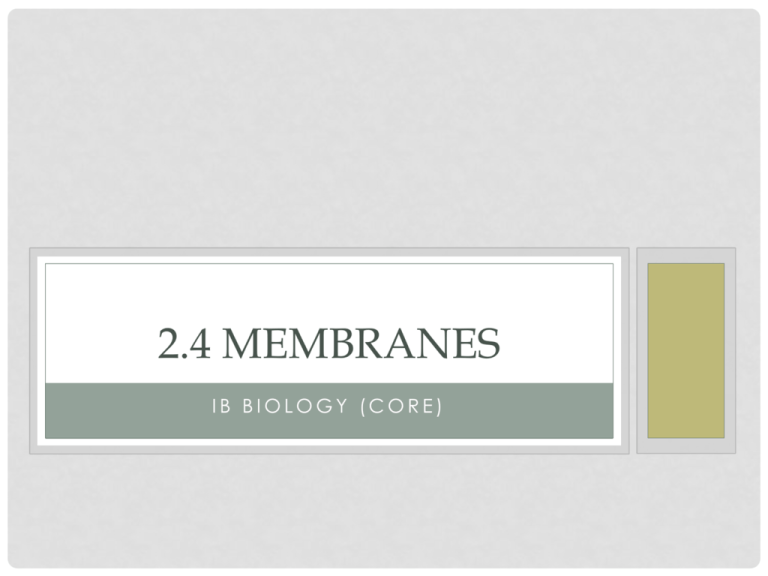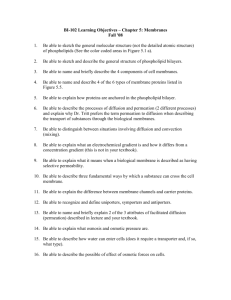2.4 Membranes - Mr Hartan's Science Class
advertisement

2.4 MEMBRANES IB BIOLOGY (CORE) THE PLASMA (CELL) MEMBRANE 2.4 ASSESSMENT STATEMENTS 2.4.1 Draw and label a diagram to show the structure of membranes. 2.4.2 Explain how the hydrophobic and hydrophilic properties of phospholipids help to maintain the structure of cell membranes. 2.4.3 List the functions of membrane proteins. 2.4.4 Define diffusion and osmosis. 2.4.5 Explain passive transport across membranes by simple diffusion and facilitated diffusion. 2.4.6 Explain the role of protein pumps and ATP in active transport across membranes. 2.4.7 Explain how vesicles are used to transport materials within a cell (between the rER, Golgi Apparatus, and Plasma Membrane. 2.4.8 Describe how the fluidity of the membrane allows it to change shape, break and re-form during endocytosis and exocytosis. FUNCTIONS OF THE PLASMA (CELL) MEMBRANE 1. To provide the cell (prokaryotes and eukaryotes) with a selectively permeable barrier/boundary. 2. To separate the interior of the cell from its external environment. 3. To provide a ‘layer’ of protection. 4. To regulate what materials/molecules can enter and exit the cell. 5. To provide points of attachment to other cells. 6. To facilitate cell to cell communication. 7. To allow for some flexibility in the structure of the cell. ANY CELL NEEDS MATERIALS IN & PRODUCTS OR WASTE OUT IN food - sugars - proteins - fats salts O2 H2O OUT waste - ammonia - salts - CO2 - H2O products - proteins Certain substances have a easier time moving through the cell membrane than others. PLASMA (CELL) MEMBRANE STRUCTURE The Cell Membrane is roughly 7-9 nm thick. KEY CHARACTERISTICS OF CELL MEMBRANES • • • • • Cell membranes surround all living cells (both prokaryotes and eukaryotes) The Fluid Mosaic Model best describes the structure of cell membranes. Cell membranes are made up of a phospholipid bilayer (2 layers of phospholipid molecules). The properties of phospholipids are such that the cell membrane is both flexible and fluid (the plasma membrane can reorient itself after a disturbance). The properties of phospholipids allow for selective permeability. Embedded in the phospholipid bilayer are other lipids (cholesterol), protein molecules, protein channels. LABEL THE DIAGRAM A TYPICAL PHOSPHOLIPID A phospholipid has a polar, phosphate head and two non-polar, tails Polar = Hydrophilic (water-attracting). “attracted to water” Non-Polar = Hydrophobic (water-avoiding). Phosphate head Inside cell 2 Fatty Acid Tails outside cell “repelled by water” PLASMA MEMBRANE ANIMATION(S) MEMBRANE PROTEIN FUNCTIONS (DIFFERENT PROTEINS WITH DIFFERENT ROLES) 1. Hormone-Binding Sites: Hormones are chemical signals that are produced in one area of the body but have an affect elsewhere. Hormones binding to protein receptors on the outside of cell membranes allow for a signal to be transmitted to the inside of the cell. 2. Enzymes: Enzymes can catalyze reactions on the inside or outside of the cell, depending on where the enzyme is located. 3. Cell-to-Cell Communication & Adhesion: Glycoproteins (sugarprotein) in the membrane allow cells to communicate with each other and to stick together to form tissues. 4. Channels for Passive Transport: Passages through protein molecules that allow very specific substances to pass through. 5. Pumps for Active Transport: Pumps use energy from ATP to move specific substances across the cell membrane. MEMBRANE PROTEINS MEMBRANE PROTEINS HOW DO SUBSTANCES MOVE IN AND OUT OF THE CELL? – AN OUTLINE I. Passive Transport A. Simple Diffusion B. Facilitated Diffusion C. Osmosis II. Active Transport A. Pump Proteins B. Bulk Transport and Vesicle Formation 1. Endocytosis a. Phagocytosis b. Pinocytosis 2. Exocytosis PASSIVE TRANSPORT • Involves the exchange of solid, liquid and gas particles between the cell and its environment. • All that needs to exist is a concentration gradient (regions of varying concentration of particles). The cell does not need to use energy (ATP) for this process to occur. Cells cannot control the direction of particle movement during this process. The process is random. Particles move as a result of kinetic energy. TYPES OF PASSIVE TRANSPORT AND DEFINITIONS Types of Passive Transport & Definitions: A. Simple Diffusion – The passive/random movement of particles from a region of higher concentration to a region of lower concentration. B. Facilitated Diffusion – Similar to simple diffusion but those substances unable to pass directly through the phospholipid bilayer, must cross via protein channels. Protein channels are highly selective and cells can control what enters and exits by inserting specific protein channels into the cell membrane. ANIMATIONS C. OSMOSIS (A SPECIAL CASE OF PASSIVE TRANSPORT) Osmosis is the passive movement of water molecules from a region of lower solute concentration to a region of higher solute concentration. • Osmosis is different than diffusion because water is a solvent (substance doing the dissolving) not a solute (substance being dissolved). IT IS THE CONCENTRATION OF THE SOLUTE INSIDE THE CELL THAT DETERMINES WHETHER and HOW MUCH WATER WILL MOVE INTO OR OUT OF THE CELL. WHY?? OSMOSIS ANIMATIONS PLASMOLYSIS IN PLANT CELLS OSMOREGULATION SUMMARY ANIMATIONS HOW DO SUBSTANCES MOVE IN AND OUT OF THE CELL? – AN OUTLINE I. Passive Transport A. Simple Diffusion B. Facilitated Diffusion C. Osmosis II. Active Transport A. Pump Proteins B. Bulk Transport & the Use of Vesicles 1. Endocytosis a. Phagocytosis b. Pinocytosis 2. Exocytosis ACTIVE TRANSPORT ACTIVE TRANSPORT IS THE MOVEMENT OF MOLECULES ACROSS MEMBRANES – THE CELL MUST USE (EXPEND) ENERGY (ATP) TO ACCOMPLISH THIS. BECAUSE ATP IS USED, MOLECULES CAN BE PUMPED/MOVED FROM AREAS OF LOWER CONCENTRATION TO AREAS OF HIGHER CONCENTRATION. Let’s Look At Some Examples of Active Transport. . . A. PROTEIN PUMPS BULK TRANSPORT (THE TRANSPORT OF ‘LARGE’ PARTICLES) B. Bulk Transport & the Use of Vesicles 1. Endocytosis (Into the Cell) a. Phagocytosis (“Cellular Eating”) b. Pinocytosis (“Cellular Drinking”) 2. Exocytosis (Out of the Cell) BULK TRANSPORT ANIMATIONS C. VESICLE FORMATION SUMMARY ACTIVE TRANSPORT ANIMATIONS EXTRACELLULAR COMPONENTS Cells will sometimes, when necessary, produce/synthesize components and place them outside the cell membrane. These are called extracellular components. Examples: 1. Plant Cell Wall 2. Glycoproteins 1. PLANT CELL WALL • Plants construct cell walls by synthesizing the extracellular components (cellulose, etc.) inside the cell and adding them to the inner surface of the cell wall. Other substances are synthesized and added to strengthen and connect the cellulose fibers. Function of the Plant Cell Wall 1. Maintain the cell’s shape. 2. Add strength to prevent the cell from bursting due to high pressures inside the cell. 3. High pressure inside plant cells prevents water uptake by osmosis. 4. High pressure inside plant cells (turgor pressure) makes cells rigid and helps to support the plant. 2. GLYCOPROTEINS (PROTEINS WITH A CARBOHYDRATE CHAIN ATTACHED) • Many animal cells, for example, synthesize glycoproteins inside the cell and secrete those glycoproteins to the outside of the cell membrane. • Glycoproteins can form an extracellular matrix (a gellike glue that can hold cells/tissues in place). Extracellular Matrix Functions 1. Supporting single layers of thin cells, which might otherwise easily tear or perforate (capillaries, alveoli, etc.). 2. Cell to cell adhesion, for example, a basement membrane helps capillary wall cells to adhere to alveolus wall cells. PASSIVE VS. ACTIVE TRANSPORT





